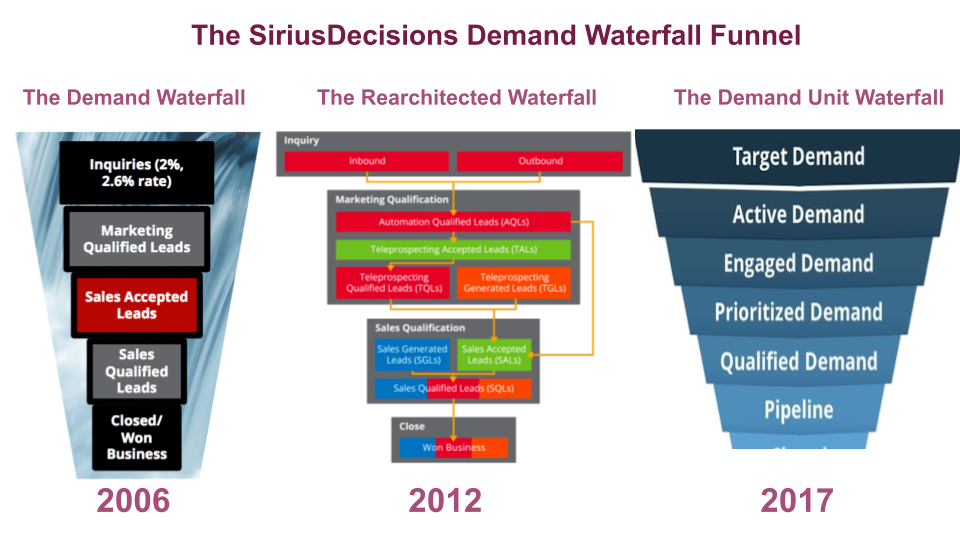
Table of Contents
-
C: Customers: Who trusts you to solve their most urgent problems.
-
ION: Start backwards. Build for true fans, not for followers.
B2B Marketing is on Life Support.

The old playbooks don’t work like they used to.
-
Advertising costs are rising…
-
Sales funnel conversion rates are plummeting…
-
Buying journeys and sales cycles are less predictable…
as dark social overtakes sales conversations as the main source of buyer education -
And ad blindness is extending further across the very demand capture tactics B2B companies know and love
Marketing departments are scrambling to find new ways to achieve sustainable growth.
With slimmer budgets, and lower headcounts.
How did we get here?

Buyer Behavior Evolved.
1: Search engines
Search engines eroded much of the information asymmetry that sellers have relied on in decades past to tilt the buying process in their favor.
2: MarTech Created Exponential Scale. And Exponential Noise.
We’ve lived with junk mail for decades. But suddenly email spam was a thing. Inbox Zero was an aspiration. We developed spam filters, and evolved powers like banner ad blindness.
3: B2B Review Sites Brought Some Order.
Product comparison tools like G2 made it simple and efficient for buyers to build comprehensive consideration lists in a few clicks. But for brands that hadn’t established a pre-existing positive relationship with the buyer… It became a features and pricing race to the bottom
4: Then - Dark Social Exploded.
Professionals became more connected to their peers, in private communities, than ever. Where they used to have to wait for that once-a-year conference, or had to rely on review on product comparison sites that may have been incentivized - they now network daily in dark social.
While all this was happening, seller behavior lagged woefully behind, with an “if it ain’t broke, dont’ fix it” stance.
Until one day, it broke.
But Selling Organizations Have Lagged Behind.
Since 2006, marketing and sales organizations have relied on the Sirius Decisions waterfall demand funnel:

The Birth of the
SiriusDecisions Waterfall Funnel
Introduced by SiriusDecisions in 2006, the Waterfall Funnel emerged in response to the growing need for a standardized lead management process. It aimed to bridge the gap between sales and marketing teams, unifying them under a common set of goals and objectives.
Key Components of the Waterfall Funnel
The Waterfall Funnel comprises stages that trace a lead’s journey from initial engagement to conversion. Each stage is associated with specific qualification criteria and handoff protocols between sales and marketing. This became the golden standard in B2B marketing for 10 years.
In 2017, the Demand Unit Waterfall was introduced, acknowledging the group nature of B2B purchasing decisions. It emphasized the importance of engaging with buying groups through account-based marketing strategies.
Criticism and Limitations
While widely adopted, the framework doesn’t account for the non-linear customer journeys prevalent in the digital age. It also doesn’t address prospects who match a company’s Ideal Customer Profile, but are nowhere near ready to enter a buying (or selling) process.
“But the
SiriusDecisions Marketing Funnel Works!”
TheSiriusDecisions demand waterfall funnel continues to generate revenue and profits for companies. It’s reasonably efficient, for prospects that are entering into a buying cycle, and encounter your top-of-funnel ads or content.
Estimates are that at most 5% of a B2B niche audience are ready and willing to buy at any given point in time.
The majority of marketing budgets, then, are spent chasing and convincing that 5%.
Even at the expense of the 95% of the market who still match the ideal client profile…
but aren’t in a buying cycle at the moment.
Meanwhile, the acceleration of feature parity is exerting downward pressure on average contract values (ACVs.)
Most would agree that this isn’t a sustainable way to do business.
Something has to change.
And slowly, with a few vanguard brands, it is.
B2B Audience Development Becomes a Thing.

What is Audience Development?
“Audience development is defining, growing,
and sustaining an engaged community of fans.
It goes beyond mere audience growth, to include
a wider marketing strategy that helps you
find new audiences, forge strategic partnerships,
and define your brand’s place in the world.”
- Anthony Kennada.
Pioneer brands like Cognism, ClickUp, PeerSignal, Lavender, HockeyStack, and dozens of others, are maintaining a sales cadence for the 5% of buyers in-market…
But for the remaining 95% of their ideal clients?
They’re developing audiences.
They’re edutaining them with engaging content.
They’re earning attention, affection, subscription, and trust.
Examples of Owned Audience Development.
Music Celebrities
-
Justin Bieber’s Beliebers
-
Taylor Swift’s Swifties
-
BTS’s A.R.M.Y.
B2C examples
-
Apple
-
Peloton
-
Nike
B2B examples
So Why Don’t More Brands Build an Owned Audience?
1: The Term “Audience” Has Been Hijacked.
The concept has been usurped by MarTech vendors and ad platforms - leading some B2B companies to settle for creating a targeted crowd. One full of their Ideal Client Prospects, but not one that has gathered to listen to that brand.
That doesn’t sound like an audience.
That sounds like a trip to the state fair.
2: Building an Owned Audience Takes Resources.
Specifically:
-
It takes time
-
It takes patience
-
It takes know-how
3: Building an Owned Audience Takes a Different Mindset.
It takes a mindset of being customer centric, not product or brand centric
This doesn’t have to mean stopping what’s currently working for lead and pipeline generation.
But it does mean diverting necessary resources to build that parallel funnel for Owned Audience development.
Every brand wants an engaged and loyal audience.
Most brands aren’t sure where to start, or how to get there.
Companies need a separate funnel, for the 95% of Ideal Customers, who aren’t ready to buy today. But likely will, in the next 12 months.
Marketing/Sales Funnel for the 5% in-market.
Audience Funnel for the 95%, not yet in-market.
The New Framework for Audience Development. AFFECCTion.
With two decades of experience building audiences, in and out of B2B organizations, I’m sharing my framework with the world for the very first time.
The new marketing funnel for Audience Development, is called
The Audience AFFECCTion Funnel.

Let’s walk through it, and tell the story of how this works.
1: A: Attention. Who knows of you.

Born in 1810, Phineas Taylor Barnum grew up in a modest family. In his 20s, he purchased and transformed Scudder’s American Museum in New York City into a popular attraction, filled with curiosities, oddities, and live performances.
Barnum understood the public’s fascination with the unusual and quickly gained a reputation as a showman. But his methods and practices have also faced criticism over the years. Exploitation of human oddities, promotion of hoaxes, lack of ethical treatment.
There are plenty of P.T. Barnum’s on the web in modern day. They trade in spectacle. Jostling. Loudness. Shock and Awe. Virality.
Getting attention does take skill.
Doing it without losing yourself, or your brand, takes character.
Definition:
In B2B marketing - getting attention - the right attention, begins with how well you can target individuals who match your Ideal Customer Profile (ICP.)
In other words: Attention starts with
who you know (targeted ad audience),
and ends in
who knows of you (awareness).
If you’re lucky.
Facebook, LinkedIn and Google will tell you that this is an audience.
(Facebook, LinkedIn and Google are wrong).

2: F: Followers: Who knows you.

Definition:
Followers are people who follow you on social media. It’s a mix of:
-
Ideal Customers
-
Curious people
-
Competitors
-
Partners
-
Investors
-
Every employee’s Mom…
Social followers don’t mind you being part of their feed, when they’re distracting themselves from work. Or life.
But the social media feed is such a fast-moving, crowded freeway, that followers may or may not remember why they started following you in the first place. Social follower numbers are notoriously misleading.
Reach:
Social media followers are a rented audience. So reach is limited by social algorithms
Metrics:
-
Follower Count Growth
-
Engagement (Likes, Comments, and Shares)
-
Direct Messages
How you earn followers:
-
By already being popular on social, in your niche
-
By creating content that resonates on a consistent cadence, for an extended period
-
By launching something big in your niche
-
By going viral in your niche
-
By buying attention via paid ads

3: F: Friends: Who likes you.

Definition:
These people love your work, and remark about you, and recommend your product
They actively and positively remark on the brand.
They’re advocates, even though they may not be fully certain what your product does.
They’ve received consistent positive results from your brand, even if it’s just your content, and keep you top of mind.
Reach:
Access varies depending on where they are - but you own space in the most important real estate. Their minds.
Metrics:
-
Referrals,
-
Testimonials,
-
Unsolicited feedback,
-
Offers to help,
-
Requests to deepen the relationship,
-
Interactions with each other
How you earn friends:
One-on-one, hand-to-hand engagement, providing consistent value, advocating for their causes, and producing results worth raving about.

4: E: Email Subscribers. Who trusts you.

Definition:
In 1999, Seth Godin published “Permission Marketing.” Seth defined “permission marketing” as anticipated, personal, and relevant:
Email Subscribers aren’t just contacts in your database. (Very important distinction.)
They’ve typically received value from your free content, and have now agreed to regularly give you their attention, in exchange for more specific and relevant value.
Most B2B companies do this completely backwards.
Reach:
This is the first stage in the Audience funnel at which you now have an Owned Audience. Reach is fairly unlimited (other than filters)
Metrics:
-
Growth,
-
Open rates,
-
CTRs,
-
Replies
How you Earn Email Subscribers:
-
Offering something of value (a lead magnet) in exchange for their email address. Then emailing them in perpetuity
-
Earning their attention in other forums like social, SEO, dark social, or via word of mouth, then offering more specific value for free, in exchange for their email address
-
Referrals from other newsletter owners in your niche

5: C: Community: Who trusts what you stand for.

Definition:
Community means… a common experience.
But not just any experience, like:
“Hey, we both watch Friends! Phoebe - am I right??
Now we’re bonded for life, I guess.”
No. The kind of experience that defines a person.
Hardship. Struggle. Overcoming adversity.
Or even still sitting in said adversity.
But, together.
Community means… fraternity.
Because of our common experience, and the fact that I probably can’t do this on my own, I choose to be vulnerable enough to share my hardship with you - and accept your burden as mine, too.
Community means “many-to-many” communication.
Not brand to buyer…
Not even buyer to brand.
Kin to kin.
And if the brand doesn’t mess it up by selling - maybe they (more likely their people) may be accepted as kin, too.
They receive as much value from each other, as they do from you. Probably more.
Which drives home the point —
Community is not about you.
If you have a community for your product or brand, and you expect people to gather around that… get a life.
Not even Nike was that arrogant.
Nike built a community around: “Just Do It.”
It’s aspirational for community members.
Nike just happens to be a part of the solution to the gap between their current state and their aspiration. But there are no Nike brand communities.
(Okay. Air Jordan sneakerheads… I take that back.) LOL!
Okay, but peep game.
Even Air Jordan sneakerheads aren’t gathering around Nike the company…
Nor are they even necessarily gathering around Michael Jordan the basketball player.
What they’re gathering around, I believe, is what Jordan stood for.
You’l see teenagers wearing Jordans today, who weren’t even born when Michael Jordan retired!
But Jordan stands for:
-
Excellence.
-
Beating the odds.
-
Owning your greatness.
-
Being in a category of one.
Kids who play basketball wear Air Jordans.
-
So do kids who play violin.
-
And kids who play football.
-
And kids who dance.
-
And kids who act.
-
And chess players.
-
And engineering geeks.
-
And stamp collectors.
It ain’t about the shoes.
It ain’t about the man.
It’s about what the aspirational idea represents.
And Michael Jordan spent 15 years building up that mythos - consider his entire career content…
So now, decades after his retirement, the product is still selling like hot cakes.
We should change that saying.
When hotcakes sell, we should say they’re “selling like Jordans.”
Community-Led Growth: Why It Matters and How To Do It Right
Reach:
Access is Unlimited (Sweet!) and Owned (But must be respected.)
Metrics:
-
Membership Growth,
-
Number of Posts,
-
Number of Replies,
-
Quality of Interactions,
-
% Active Monthly Members
How you Earn Community Members:
-
Build a reputation in a marketplace as a person or company that stands for a cause they are passionate about
-
Be a thought leader in the town’s square - provide free value
-
Community can start in those public town squares - social media
-
Offer a gathering place for more private communication, better facilitation of conversations, additional value (-ex- group calls, etc.)
-
Continue to provide thought leadership value in the town’s square, and occasionally share about your community

6: C: Customers: Who trusts you to solve their most urgent problems.
[IMAGE 13]

Definition:
These are the folks who’ve bought at least one thing from you.
They’ve trusted you enough to pay for your offerings.
Some will be happy.
Many may be indifferent.
And some may be dissatisfied.
But they’ve all ponied up and trusted you - that first time.
What you do with that trust, could make-or-break your business.
Reach:
Access varies depending on where they are - but you own space in the most important real estate - their minds.
How you earn them:
One-by-one, hand-to-hand engagement, providing consistent value, advocating for their causes, and producing results worth raving about

7: T: True Fans: Who “stans” for you.

Definition:
According to Kevin Kelly’s 2008 article “1000 True Fans”:
“A true fan is defined as a fan that will buy anything you produce.
These diehard fans will drive 200 miles to see you sing;
they will buy the hardback and paperback and
audible versions of your book;
they will purchase your next figurine sight unseen;
they will pay for the “best-of” DVD version of your free youtube channel;
they will come to your chef’s table once a month.”
Who Stans for You?
While some say the term is a combination of “fan” and “stalker,” “stan” was first coined in 2000 when Eminem dropped a twisted allegory in a song called “Stan,” about a man who was pushed to the edge when his idol wouldn’t answer his fan mail.
The word used to be synonymous with overzealous or obsessed.
But nearly 20 years later, it’s become a badge of honor for fans committed enough to show up and go all out for their favorite star on the Internet.
Whether you call them “Stans”, “Superfans”, or “True Fans”, these are your fanatic, repeat customers.
They’ve received great results from your brand
They’re the ones who:
-
Buy your records
-
Attend your live shows (front row)
-
Collect all the merch (and take pictures in it.)
-
Relish get-togethers with the community
-
Gain status by sharing the experience with others not yet in the tribe
You may have thousands of customers.
But do you have 1,000 true fans on your team?
If not, we have promises to keep.
And miles to go… before we sleep.
Reach:
Owned because they’re customers, and pretty much unlimited. Much of it is 1-to-1 communication.
Metrics:
-
Repeat purchases
-
Speed of purchase / renewal
-
Requests for new products
-
Number of testimonials
How you earn true fans:
-
One-by-one, hand-to-hand engagement,
-
providing consistent value,
-
advocating for their causes, and producing results worth raving about
-
Connecting them with one another, to reinforce the halo effect
-
Going beyond just solving their problems - creating experiences and excuses to bring them together
-
Incorporating them in your innovation cycle. What do they want and need next?

8: ION: Start backwards. Build for true fans, not for followers.
Definition:
an atom or molecule with a net electric charge due to the loss or gain of one or more electrons.
A charged subatomic particle.
It’s the core essence of what attracts your Ideal Customer Profile (ICP) to you.
More than features and benefits…
Price or service…
It’s your r’aison detre. Your reason for being.
The argument is made in some corners, that no one cares what their bleach company stands for . They just want to buy bleach,
That may be largely true.
But also: Bleach is a commodity, and is completely undifferentiated from one vendor to the next,
Consider vodka. It’s also an undifferentiated product, but people have their brand preferences .
What do your people most care about, wort about, obsess about?
What combination of those things is your company uniquely equipped to gather the audience around?
Find it.
Mine it.
Charge that ion.
And work it into everything you do.
Examples of that?
- Apple: Design
- Red Bull: Adventure
- Disney: The magic of childhood
- Harley Davidson. Standing out from the crowd.
It’s possible in the B2B space, too. And in this article series, we’ll explore exactly how to do that.
The biggest secret about your “ion” - is that it doesn’t have to be relegated to the bottom of the funnel.
In fact, many corners of the business profession now regard the funnel model as incomplete… because it stops once the financial transaction happens.
What if - instead of a funnel, we considered a flywheel with “Developing an ion that your true fans will love” as the entry point?
Start backwards, with the smallest possible unit.
Build for true fans, not for followers.

It’s Time to Develop Your Audience.

B2B companies don’t need to throw the baby out with the bathwater.
They don’t need to get rid of their Demand Waterfall funnel. It still works… but only for the 1-5% of prospects who are ready to buy.
For the remaining 95% or more of your desired marketplace - it’s time to develop your own audience.
The Audience AFFECCTion funnel is your step-by-step formula, to how.
In future articles, we’ll walk you step-by-step through this blueprint, to make it paint-by-numbers easy.
Subscribe to AudiencePlus, to not miss a piece of the puzzle.

Related Resources.
How to Build An Audience for Your Business (Without Social Media)
How to Build an Owned Audience in 2023
Bolaji Oyejide | About the Author
Founder, B2B Demand Creators
A B2B SaaS VP of Marketing with 20 years experience, Bolaji advises companies on how to generate sustainable demand through Audience Development.
Bolaji’s audience-building adventures include.
-
A 30-person audience of pre-teen boys, as a volunteer youth soccer coach of 8 years (North Carolina Volunteer Coach of the Year, 2020)
-
A 3,000-person audience of parents for a virtual summit with 40 top industry speakers (The Raising Resilient Kids Summit, 2020)
-
A 10,000-person audience of fiction writers in an infoproduct & coaching business (Bold Publishing, 2012-2019)
-
A 25,000-person audience of college grads, in one of the world’s first social.networks on the web (HBCUnetwork, 1999-2007)
-
A 250,000-person audience of kids and parents who love heroic kid’s music, parenting advice on how to raise brave kids, and kid superhero fiction. (Brave Young Heroes, 2010-2018)
Bolaji blends marketing principles, human psychology, and storytelling into bingeworthy content experiences that audiences crave.
In his spare time, Bolaji raises a family, coaches youth soccer, and reads comic books.




